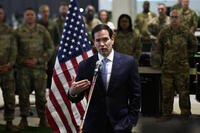Jacquelyn Schneider is a Hoover Fellow at Stanford University's Hoover Institution and a non-resident fellow at the Naval War College.
On April 2, Capt. Brett Crozier, commander of the aircraft carrier Theodore Roosevelt, was fired after a memo he wrote requesting support for his COVID-19 stricken crew made its way to the San Francisco Chronicle.
The memo ignited a veritable brouhaha for the Navy and highlighted issues that have been simmering for both the service and the Defense Department -- from civilian-military relations in the Trump administration to Navy leadership and accountability.
And while these issues have received significant attention, the exchange between Crozier and then-Acting Navy Secretary Thomas Modly spotlighted an under-discussed tension for the service and the DoD. Modly resigned amid backlash on Tuesday.
In his memo, Crozier said, "We are not at war." He argued that, "In combat, we are willing to take certain risks that are not acceptable in peacetime," but that the risk of losing sailors' lives to the virus in peacetime would be tragic and unnecessary.
Modly retorted that "neither are we truly at peace," suggesting that, in the era of great power competition, even the perception of losses to operational readiness would have immediate strategic implications.
This repartee may have been about one aircraft carrier, but it is emblematic of larger tensions that the Navy and the DoD must resolve as they navigate the future post-COVID-19. For too long, the DoD has used the strategic objectives of deterrence and influence to justify "presence" missions and capabilities. But short-term presence comes at the sacrifice of long-term fleet and DoD health. COVID-19 will force immediate and long-term choices about this sacrifice. How can we think about this trade-off?
First, what are presence missions? All of the services conduct presence missions in some form, whether they are B-2 Spirit shows of force over the Korean peninsula, freedom of navigation operations in the South China Sea, forward deployment of ground and air forces at temporary bases all over the world, or port calls in allied and friendly nations.
Presence missions prioritize influence and deterrence over combat readiness and are meant to deter states from closing trade routes (like the Persian Gulf or the Straits of Malacca), to uphold international agreements on global waters (perhaps most notably the South China Sea), or to shore up credibility with allies. They demonstrate U.S. capability and willingness to deploy weapons and warriors all over the world -- and in a short period of time -- as a visible reminder of American military power.
These kinds of missions are a core part of the Navy's strategy. The Theodore Roosevelt, for example, was on a mission "providing maritime security and maintaining freedom of the seas in accordance with international law and customs." It was underway as "the centrepiece of deterrence, providing our national command authority with flexible deterrent options and a visible forward presence."
Further, the 2015 Navy strategy articulates a "focus on providing presence around the world in order to ensure stability, build on our relationships with allies and partners, prevent wars, and provide our Nation's leaders with options in times of crisis."
Part of why these presence missions (especially by carrier strike groups) have become such an important part of the U.S. military strategy, especially in Asia, was the link between a 1996 carrier group transit of the Taiwan Straits and the subsequent cooling of the U.S.-China Taiwan crisis. But the Taiwan case is a rare example, whose long-term effects on catalyzing Chinese military modernization are under debate.
The problem with these missions is not in their purported purpose (to deter, influence and create credibility with allies), but instead in whether you can tell if they are successful. How do you prove that any country is not doing something because we have X aircraft carriers at sea?
And, in fact, China continues to build outposts throughout the South China Sea and harass neighbors in contested waters, despite U.S. presence missions in the area. Would Chinese behavior be worse if the U.S. had fewer naval vessels conducting presence missions in the area? It is extremely hard to say. As all deterrence or influence campaign planners (or scholars) would attest, building measures of effectiveness for these types of missions is notoriously difficult.
In social science, we call these kinds of theories that are very difficult to prove or disprove non-falsifiable. This is a scientific taboo -- one that sets alarm bells off that a research study's conclusions may be either invalid or biased. But social science taboos like falsifiability wouldn't matter if there was no trade-off between presence missions and other operational requirements.
The problem is that these (hard-to-measure-the-success-of) presence missions come at a cost to the long-term readiness and health of the DoD fighting force (something that seems essential to winning long-term great power competition).
A fleet always ready at sea sacrifices long-term sustainment requirements: maintenance, sailor morale and even some training. Overworked, overtired and Band-Aided sailors and ships lead to accidents. Similarly, air forces focused on alert or show-of-force missions lose readiness on other more tactically difficult mission sets, like basic fighting maneuvers or suppression of enemy air defenses. Further, ground forces on short-term deployments to allied nations expend valuable logistical support and training time.
The Navy is not alone building strategies on deterrence, influence or presence that offer no timelines or real ways of measuring strategic effectiveness. CYBERCOM's "persistent engagement" and even the double-decade fight in Afghanistan lack measurement and require seemingly endless resources.
Prior to this pandemic, the DoD was already struggling with whether the pace of day-to-day presence missions were eroding the U.S. military's ability to respond to long-term Chinese threats to build regional influence. The 2018 National Defense Strategy, for example, grapples with balancing the needs of alliance credibility and competition with readiness requirements across the forces.
Enter COVID-19.
The current health crisis will be a wake-up call for the DoD, which has not had to justify how the cost of these missions translates to national security. "Deterrence" has hidden far too much budget bloat and lack of strategic priorities, while influence and competition have become bywords for new authorities, task forces and resources. Deterrence, influence and alliance credibility are all important for U.S. strategy, but for too long we have let the value of these missions overshadow the tough assessments required about when and how they can be more successful.
As the strain on the economy and public health grows, DoD budgets will shrink. In the inevitable balance between butter and guns, it's going to be time for more butter, so the DoD better justify those guns.
-- The opinions expressed in this op-ed are those of the author and do not necessarily reflect the views of Military.com. If you would like to submit your own commentary, please send your article to opinions@military.com for consideration.















